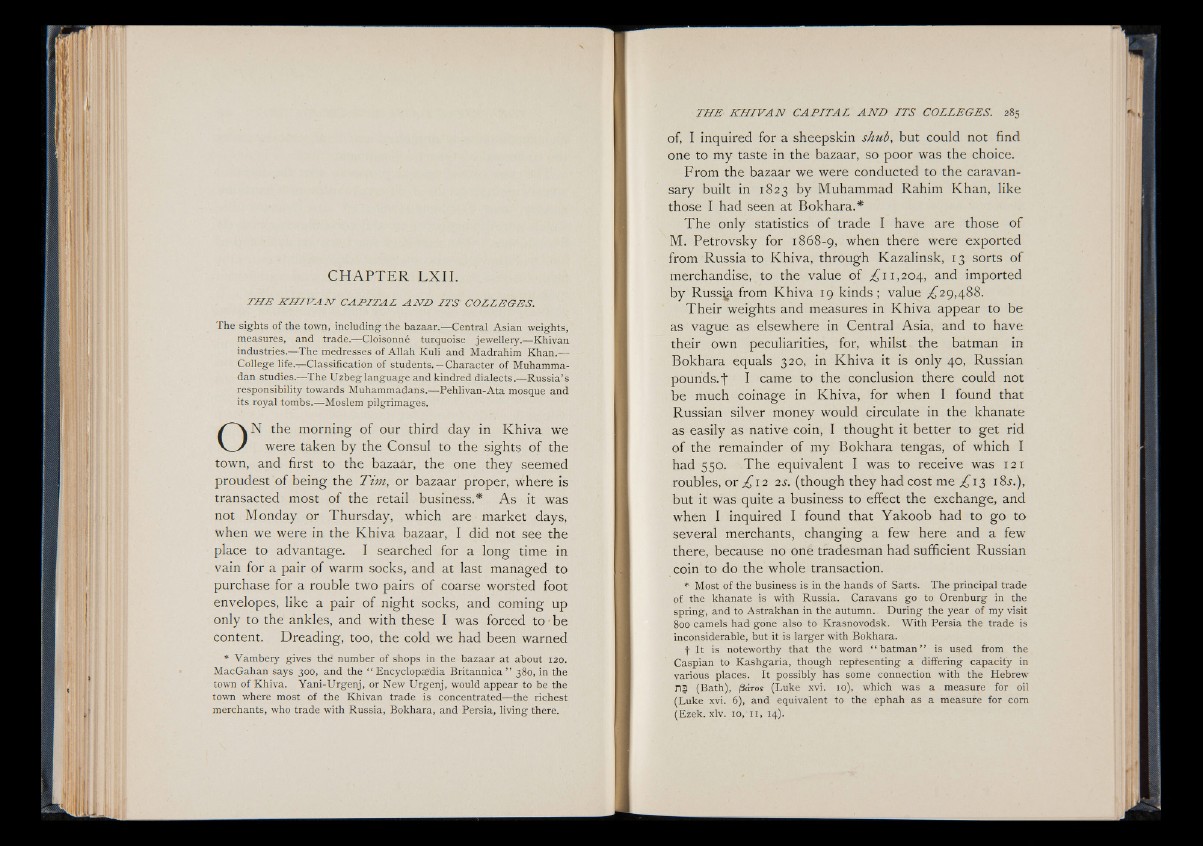
C H A P T E R L X I I .
THE K H IV A N C A P ITA L A N D IT S COLLEGES.
The sights of the town, including the bazaar.— Central Asian weights,
measures, and trade.— Cloisonné turquoise jewellery.— Khivan
industries.— The medresses of Allah Kuli and Madrahim Khan.—
College life— Classification of students. — Character of Muhammadan
studies.— The Uzbeglanguage and kindred dialects.—Russia’s
responsibility towards Muhammadans.— Pehlivan-Ata mosque and
its royal tombs.—Moslem pilgrimages.
ON the morning of our third day in Khiva we
were taken by the Consul to the sights of the
town, and first to the bazaàr, the one they seemed
proudest of being the Tim, or bazaar proper, where is
transacted most of the retail business.* As it was
not Monday or Thursday, which are market days,
when we were in the Khiva bazaar, I did not see the
place to advantage. I searched for a long time in
vain for a pair of warm socks, and at last managed to
purchase for a rouble two pairs of coarse worsted foot
envelopes, like a pair of night socks, and coming up
only to the ankles, and with these I was forced to be
content. Dreading, too, the cold we had been warned
* Vambeiy gives the number of shops in the bazaar at about 120.
MacGahan says 300, and the “ Encyclopaedia Britannica ” 380, in the
town of Khiva. Yani-Urgenj, or New Urgenj, would appear to be the
town where most of the Khivan trade is concentrated—the richest
merchants, who trade with Russia, Bokhara, and Persia, living there.
of, I inquired for a sheepskin shub, but could not find
one to my taste in the bazaar, so poor was the choice.
From the bazaar we were conducted to the caravansary
built in 1823 by Muhammad Rahim Khan, like
those I had seen at Bokhara.*
The only statistics o f trade I have are those of
M. Petrovsky for 1868-9, when there were exported
from Russia to Khiva, through Kazalinsk, 13 sorts o f
merchandise, to the value of 11,204, and imported
by Russj^. from Khiva 19 kinds ; value .£29,488.
Their weights and measures in Khiva appear to be
as vague as elsewhere in Central Asia, and to have
their own peculiarities, for, whilst the batman in
Bokhara equals 320, in Khiva it is only 40, Russian
pounds, f I came to the conclusion there could not
be much coinage in Khiva, for when I found that
Russian silver money would circulate in the khanate
as easily as native coin, I thought it better to get rid
of the remainder of my Bokhara tengas, o f which I
had 550. The equivalent I was to receive was 121
roubles, or £ 12 2s. (though they had cost me £ 13 18^.),
but it was quite a business to effect the exchange, and
when I inquired I found that Yakoob had to go to
several merchants, changing a few here and a few
there, because no one tradesman had sufficient Russian
coin to do the whole transaction.
* Most of the business is in the hands of Sarts. The principal trade
of the khanate is with Russia. Caravans go to Orenburg in the
spring, and to Astrakhan in the autumn.. During the year of my visit
800 camels had gone also to Krasnovodsk. With Persia the trade is
inconsiderable, but it is larger with Bokhara.
f It is noteworthy that the word “ batman” is used from the
Caspian to Kashgaria, though representing a differing capacity in
various places. It possibly has some connection with the Hebrew
na (Bath), (3dros (Luke xvi. 10), which was a measure for oil
(Luke xvi. 6), and equivalent to the ephah as a measure for com
(Ezek. xlv. 10, 11, 14).